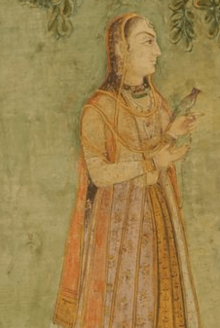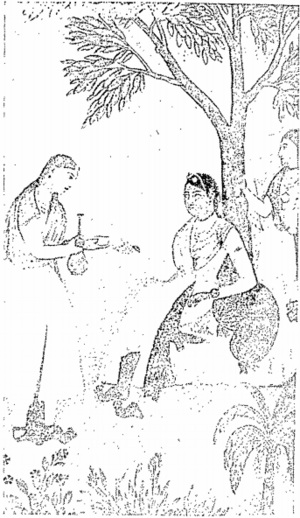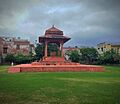Jagat Gosain facts for kids
Quick facts for kids Jagat Gosain |
|||||
|---|---|---|---|---|---|
| Rajkumari of Marwar Empress consort of the Mughal Empire |
|||||

Jagat Gosain holding a Bulbul c.17th century
|
|||||
| Born | Shri Manavati Baiji Lall Sahiba 13 May 1573 Jodhpur or Phalodi, Marwar, Mughal Empire (present-day Rajasthan, India) |
||||
| Died | 8 April 1619 (aged 45) Akbarabad, Agra Subah, Mughal Empire (present-day Agra, Uttar Pradesh, India) |
||||
| Burial | Dehra Bagh, Agra (present-day Jodhbai Ki Chattri at Arjun Nagar, Agra) | ||||
| Spouse | |||||
| Issue |
|
||||
|
|||||
| Dynasty |
|
||||
| Father | Raja Udai Singh | ||||
| Mother | Rani Rajavat Kachawahi Manrang Devi | ||||
| Religion | Hinduism | ||||
Manavati Bai, also known as Jagat Gosain, was an important empress of the Mughal Empire. She was born on May 13, 1573, and passed away on April 8, 1619. She was the second wife of Jahangir, who was the fourth Mughal emperor. She was also the mother of Shah Jahan, who later became a famous emperor himself.
Jagat Gosain was known by many names. These included Mani Bai, Manmati, and Jodh Bai, which means 'Princess of Jodhpur'. She was also called Taj Bibi, meaning 'Lady of the Crown'. After her death, she received the special title Bilqis Makani, meaning 'Lady of the Pure Abode'.
She was a Rajput princess from Marwar, an area known today as Jodhpur. Her father was Raja Udai Singh, also called Mota Raja (the fat king). He was a ruler from the Rathore dynasty. Her brothers were Sawai Raja Sur Singh and Maharaja Kishan Singh, who founded the Kishangarh State.
Contents
Jagat Gosain's Family Background
Jagat Gosain was born Manavati Bai on May 13, 1573. People often called her Jodh Bai, meaning 'the Princess of Jodhpur'. She belonged to the Rathore family, a brave Rajput clan. Her father was Raja Udai Singh, the ruler of Marwar. He was known as Mota Raja.
Her mother was Rajavat Kachvahi Manrang Devi. She was the main wife of Raja Udai Singh. Her grandfather was Maldeo Rathore. Under his rule, Marwar became a very strong Rajput Kingdom. It stood against foreign rulers and challenged them for control of northern India.
Maldeo Rathore did not want to join forces with either the Sur Empire or the Mughal Empire. His son, Chandrasen Rathore, continued this policy. After Maldeo Rathore died in 1562, a fight for the throne began. Chandrasen became king in Jodhpur.
However, his rule did not last long. Emperor Akbar's army took over Merta in 1562 and Jodhpur in 1563. After Rao Chandrasen died in 1581, Marwar came under direct Mughal control. In 1583, Akbar gave the throne back to Udai Singh. Unlike earlier rulers, Udai Singh agreed to join the Mughals. He then served in the Mughal army.
Marriage to Prince Jahangir
Jagat Gosain caught the eye of Prince Salim, who later became Emperor Jahangir. This happened when he was at a royal event. He immediately wanted to marry her. Emperor Akbar was not sure at first. But Hamida Banu, Salim's grandmother, helped convince him.
Jagat Gosain married the 16-year-old Prince Salim on January 11, 1586. The wedding was a grand event. Emperor Akbar himself attended with the ladies of the harem. The ceremony included both Hindu fire rituals and Muslim customs. Priests chanted Sanskrit verses, and a Qadi was present. Many important military and civilian leaders also attended.
This marriage was very good for the Marwar family. It strengthened their alliance with the Mughals. This bond was important because Jahangir and Shah Jahan were connected by blood to the Rajput family. After this marriage, Udai Singh and his relatives gained the trust of the Mughal rulers. They received many royal favors.
Jagat Gosain was known for her beauty and charm. She also had a soft voice, quick wit, and courage. These qualities made her very dear to her husband in their early years. She was also a good singer and skilled in music. After her marriage, she received special training from expert musicians.
Children and Later Life
In 1590, Jagat Gosain gave birth to her first child, a daughter named Begum Sultan. Sadly, she died at the age of one. On January 5, 1592, she had Salim's third son. His grandfather, Emperor Akbar, named him 'Khurram', which means "joyous." This prince would later become the famous Emperor Shah Jahan.
Emperor Akbar believed Khurram's birth signs were very lucky. So, he insisted that Khurram be raised in his own palace, not Salim's. Khurram was cared for by Akbar's first wife, Ruqaiya Begum. She raised him with much love.
After Akbar died in 1605, Khurram returned to his father's home. He was then supervised by his mother, Jagat Gosain. He loved and cared for her deeply. He even called her Hazrat in his court records.
Jagat Gosain had two more children. In 1597, she gave birth to a daughter, Luzzat-un-Nissa, who died young. Her fourth child and second son, Shahryar Mirza, was born in 1605.
Some historians believe Jagat Gosain lost her husband's favor early on. Others say she was Jahangir's favorite wife until Nur Jahan arrived. Nur Jahan became Jahangir's favorite wife after their marriage in 1611. Even before Nur Jahan, Jahangir's chief wife was Saliha Banu Begum. She held this title until her death in 1620.
Jahangir's health worsened due to his lifestyle. He also became less interested in running the government. Nur Jahan was allowed to manage state affairs, which gave her great power. This situation later became a challenge for Jagat Gosain's son, Prince Khurram.
The Jahangiri Mahal at Agra Fort was Jagat Gosain's home, chosen by Jahangir. The western part of the building had a special temple for her. The Kanch Mahal, sometimes called Jodh Bai's Mahal, is located at Sikandra. It is said that Jahangir built it for Jagat Gosain. The area called 'Taj Ganj' in Agra is also believed to be named in her honor. She is also said to have started a village called Sohagpura, known for making glass bangles.
Empress Jagat Gosain's Death
In 1619, while staying at Fatehpur Sikri, Jagat Gosain became very ill. No treatment helped her. She passed away on April 9, 1619, in Akbarabad, which is now Agra. Emperor Jahangir wrote about her death in his diary:
On Friday, the 30th, the mother(Jodh baī) of Shāh-Jahān attained the mercy of God.
—Jahangir, Emperor of India, Volume II p. 84
Shah Jahan was heartbroken by his mother's death. Jahangir noted that Shah Jahan was inconsolable.
The next day I myself went to the house of that precious son, and having condoled with him in every way, took him with me to the palace.
—Jahangir, Emperor of India, Volume II p. 84
According to Muni Lal, Shah Jahan was so sad that he "attended no public entertainment for twenty-one days and ate only simple vegetarian meals." His wife, Arjumand Banu, helped him through his grief. She oversaw giving food to the poor during the three-week mourning period. She also led readings of the Holy Quran each morning. She helped her husband understand life and death and asked him not to grieve so much.
After her death, Jahangir ordered that she be called Bilqis Makani. This means "the Lady of Pure Abode" in all official papers. Her death, along with the retirement of Mariam-uz-Zamani, led to less Rajput influence in the Mughal court.
She was buried in Dehra Bagh near Noor Manzil, now Arjun Nagar, Agra. This was her wish. Her tomb was a large square building with a high dome, gateways, and towers. It had a garden and a large underground chamber. A marble cenotaph was believed to be inside. This tomb was destroyed in 1832 by the British, who used its materials for other purposes.
In 1921, a chhatri was built to mark her tomb site. A chhatri is a dome-shaped pavilion. It was designed by the Archeological Superintendent Office. The Chhatri stands exactly where her original burial chamber was. The Maharajadhiraja of Burdwan paid for its construction. It cost about 200 rupees in 1921. This Chhatri is known as 'Chhatri making the site of the Empress Jodhbai's Tomb' or simply Jodhbai Ki Chhatri'.
Jagat Gosain's Children
Jagat Gosain had three confirmed children with Jahangir:
- Begum Sultan (born October 9, 1590, in Lahore; died September 1591)
- Muhammad Khurram (born January 5, 1592, in Lahore; died January 22, 1666, in Agra Fort; buried in Taj Mahal, Agra)
- Luzzat-un-Nissa (born September 23, 1597, in Kashmir; died around 1603 in Allahabad)
Jagat Gosain may have had another child:
- Shahryar Mirza (born January 16, 1605, in Agra; died January 23, 1628, in Lahore; buried in Lahore)
Images for kids





